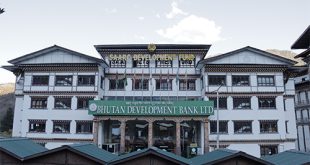Bhutanese mining companies with stone quarries under Wangduephodrang supplying materials to the Punatsangchhu hydropower project I and II (PHPA), have raised concerns over foriegn contractors operating mines in the project areas.
While some referred to national laws which don’t allow foreigners to operate mines in the country, some cited economic problems owing to unmatched competition from the Indian contractors who have been awarded the works under PHPA.
Local miners say the government has already underestimated their capacity to supply materials for the project by blindly approving the recommendations of PHPA that the quarry activities be given to Indian companies.
Records with DGM show that two lease agreements with L&T was signed on 18 February, 2011 and November 23 last year. The agreement with Gammon was signed on 1 February, 2011 and the one with HCC on July 19, 2011.
Legal aspects and clearance processes
The Department of Geology and Mines (DGM) and National Environment Commission (NEC) has allowed PHPA to give out stone quarry operations to the Indian contractors- Larsen & Toubro Limited (L&T), Gammon Construction Limited and Hindustan Construction Company specifically for the supply of materials to the project and not for any commercial purpose.
Some local contractors said it is unfair on the government’s part since the locals are capable of supplying the materials although they don’t have the capacity to execute the actual hydropower projects such as digging tunnels, erecting dams and building powerhouses.
Bhutanese miners also raised concerns on how the foreign companies can operate their mines when the Mines and Minerals Management Regulations 2002 clearly define the eligibility to obtain a mining lease as “any Bhutanese individual, licensed firm or a company shall be eligible to obtain a mining lease.”
The contractors also cited the Mines and Minerals Management Regulations which define “company” as “any organization registered under the Companies Act of the Kingdom of Bhutan, 2000.”
Many miners who spoke to The Bhutanese said it is a clear case of ‘fronting’ because “the government has leased the mines under PHPA’s name while it is being sub-leased to foreign contractors by the project authority.”
The Economic Affairs Secretary, Dasho Sonam Tshering said there is no question of fronting at all. “This is not a sub-contract work. The contractors are working for the project and the quarries are required by the project. They are not selling the stones anywhere but are meeting the needs of the project,” he said.
“Private sector hasn’t been barred from supplying to PHPA. If they meet the requirements at a competitive rate, I am sure the project will use it.”
He said DGM has given the quarries to PHPA and not to the Indian contractors and if there is any non-compliance in terms of environment, NEC will take up the issue. “The project authority will be responsible. The contractors are not making any profit. The stones from there are an input to their project. The mine is not leased out to them but to PHPA for use by the project,” he added.
Tshering Choden of NEC said “First of all the locals don’t have the capacity. It’s a huge project and a lot of materials need to be delivered on time. If you look at their location it’s far away from the project and the amount of time taken for transportation or expenses incurred is much more.”
Many of the quarry owners in the area said it took them at least a tedious four years or more to obtain a lease but the foreign contractors under the name of PHPA has acquired everything in just few months.
Adverse impact on local businesses
Local contractors in the area said huge investments to the tune of Nu 100mn by each miner has been made to operate mines over the last four or five years which is all gone to waste as the main market (PHPA), has been snatched by Indian contractors.
BCCI president Ugyen Tshechup said “on one hand the government talks about giving equal opportunity and sharing the benefits equally. On the other hand they give everything to the foreigners. Even though there are over five mines in the Punatsangchhu owned by local business people, irrespective of whether the local business people have the capacity to supply all the stone aggregates and other materials requirements of the hydropower projects, the government is going on giving mines to outsiders.”
NEC’s Tshering Choden said “if you look at the proposals of the local quarries it is mentioned that they are going to cater to the entire Bhutanese market and the boom of construction in the country. Their main goal is not about supplying to PHPA.”
Local quarry owners said millions of investments were made to supply stone aggregates to PHPA which is all going to amount to waste if foreign companies that are huge ones compete with them.
The local contractors and BCCI representatives said they wanted to make it very clear there was no need for PHPA to ‘sub-lease’ the quarry to Indian companies. The country’s private sector is more than capable to cater to any demand of stone aggregates across the country.
One contractor said “although it can be true that the lack of a domestic technological base and skill based capacity is primarily responsible for the influx of foriegn contractors into the country, many local businesses cling to an alternate view, that Bhutan’s economic relations are not symbolic of a ‘win-win’ setting, thus negating the concept of mutual benefit.”
“Four additional companies, all foreign ones are given license to mine under PHPA’s name in addition to the already enough Bhutanese contractors who are very much capable of doing the job there,” the BCCI president said.
The auxiliary economy created by the hydro power industry is thus perceived as depriving or reducing the space for Bhutanese stakeholders.
The managing director of PHPA, R. N. Khazanchi said everything was done in order to ensure that the project is completed within the time frame and that supply of materials are of high quality and fast paced. “In case the resources from Bhutanese and Indians are the same and at the same price, then we prefer Bhutanese. Indian contractors here, especially L&T doing the major work, when they do the work they need materials at a very fast pace committed to complete a particular job within a time frame,” he said.
Khazanchi said the best way out is that the Local contractors and Indian contractors sit together and work out some plans. “For me I am open to everything. It depends on these gentlemen to sit together and work out something. If they are not able to cope up with the pace, they can have an arrangement like a certain percentage that each can supply so that work flow is not hampered.”
Stone crushing plants
Local miners also questioned the stone crushing plants set up by Indian companies at their quarries.
“Stone crushing is a specific business, one that requires a separate industrial license and is not open for foreign direct investment,” a contractor said.
Almost all contractors said “this business is surely outside the scope of the construction contract packages that L&T, Gammon and HCC have with PHPA, so why have they been allowed to establish their own stone crushing plants?”
“Now our stone crushing machines have been closed down for the time being and there are huge overhead costs because after PHPA opened up their own plants there is no market that we can supply our materials,” a contractor in the area said.
One of the major issues raised by the local contractors is the quarry given to L&T at Nerichhu, the land which was earlier required by the DGM to be kept as a ‘buffer zone’. The land fell between two stone quarries and owing to safety reasons; mining was prohibited in that area. However, recently L&T has started developing it as a stone quarry. The area falls under Taksha stone quarry and Taksha silli stone quarry.
A local miner said “we were not allowed at all to operate in that area as they cited environmental reasons and other rules. So where are the rules when it comes to L&T?”
To this, a mining engineer with DGM said it was a miscommunication problem. “One of our officials during a meeting had said it but there are no rules as such. So, when we were processing the quarry for PHPA, we weren’t aware of the buffer zone at all,” he said.
A BCCI representative said the two local miners on both sides of the buffer zone have invested over Nu 8mn to Nu 10mn. “They were solely depending on supplying to the Punatsangchhu projects and then
The BCCI president said “we hope that the government will look at this as a serious issue and address this issue for the private people who have invested in that place.”
 The Bhutanese Leading the way.
The Bhutanese Leading the way.




I think the government really needs to study this in more detail. After all giving work to our own nationals will not in anyway harm us but will increase the amount of funds remaining in the country from the Hydroprojects. I think it is unfair for the govt to provide mines to the hydroprojects. If that is the case can every project in Bhutan demand a mine and not use the existing mines that have been evaluated through strict procedures? To make matters worse, such mines’ clearances are expedited. So in other words anyone who has the money and can afford to do big projects will get things expedited and the others will have to follow the same snails pace? It’s not like the quarry’s in question are being taken out and value added thus being a special input to the Hydro project. Any quarry can supply stones to the projects. In fact Bhutanese citizens should have been given the mines and asked to supply to the project. If the prices were too high more mines should have been leased out so that market rates would take over. What don’t understand what is happening here.
If the supplying contract was given to the local or few influential mine operators, they would have messed up the works like the AIRPORTS PROJECTS. Our miners have no capacities to cater to such a huge prjects. If we had allowed Bhutanese miners- how many and who would have benefited from the projects.Since our miners have small or medium manufacturing units the projects would drag on for many years. Therefore, we have done right thing by allowing big contractors like L&T,Gabon etc.
If the article is read and understood in the context of Punatsangchhu I and II Projects, one can easilly understand which miner is affected. Firstly, the quarry operators in Upper Wangdue are not affected because they are competing in the market and the Indian companies are lifting boulders from them. Only two quarries in Taksha and Wakhleytar are affected as they are not willing to supply at the rates the other operators are supplying.
While it is easy to say that we have to give business to local contractors/ businesses, one has to keep the borader picture of finishing the two mega projects on time. The Contractors are given captive mines to roll the ball in their court, they cannot claim that the stones in the quarry were of inferior quality or that there was insufficient construction material. If the Quarries are given to local businesses and if the local businesses are not able to supply the required quantity or of proper quality, the projects will get delayed. Weighing the pros and cons, the allotment of captive quarries will ensure completion of the projects on time or even earlier which will benefit the country at large while alloting the quarries to local businesses might enrich a few influential businesses but the nation at large risks losing.